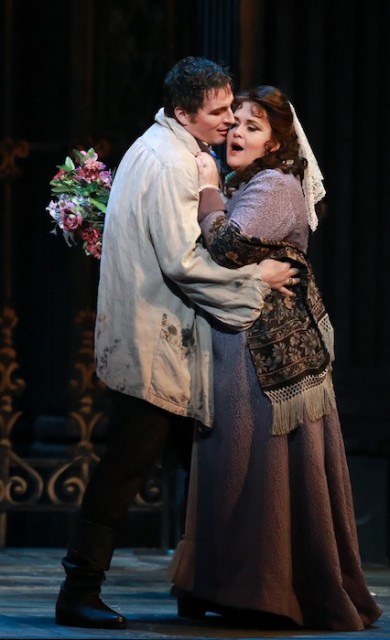Solid singing, tepid conducting make for a mixed “Tosca” at Palm Beach Opera

Riccardo Massi and Keri Alkema starred in Palm Beach Opera’s “Tosca” Friday night at the Kravis Center. Photo: Bruce Bennett
An impressive and evocative series of big-budget sets recreated historic Roman buildings for Palm Beach Opera’s production of Puccini’s Tosca, providing an atmospheric setting for one of the world’s most popular operas.
The company’s season-opening performance Friday night at the Kravis Center in West Palm Beach was a respectable one, with real strengths in all the principal roles, if not generating the shattering drama that the most effective productions can deliver. The main weakness was an underpowered performance by the orchestra under conductor David Stern, which often came off as plodding and prosaic, without the warmth, passion and drive demanded by Puccini’s score.
The sets, from Tulsa Opera, reproduced the interior of the church of Sant’Andrea della Valle, with its cavernous nave, grotto and statues, the Palazzo Farnese, Scarpia’s ornately furnished headquarters, with an immense fireplace, candelabras and towering double doors, and the Castel Sant’Angelo, a gray and menacing setting for the last moments of the opera. All were atmospherically illuminated by lighting designer Stuart Drake.
As Tosca’s lover, the painter Cavaradossi, the tall, slender Italian tenor Riccardo Massi looked the heroic part—not essential in an art form that doesn’t prize realism, but nice when it happens. His was a realistic, subtly acted portrayal of the artist, displaying good-natured exasperation at Tosca’s jealousy and then fleeting despair as he hears her naive description of the plan for his (supposed) mock-execution.
He brought a focused, smooth, liquid voice to the role. In his first-act aria “Recondita armonia,” his high notes took some effort to reach but were strong when he got there. His powerful upper register was a strength throughout—when he enters at the climax of his first-act duet with Tosca, and after he hears of Napoleon’s triumph on the battlefield, his sustained cries of “Vittoria! Vittoria!” filled the hall with ringing tones. All these qualities were apparent in “E lucevan le stelle,” although the aria came off as too pristine, without the raw emotion of a man whose heart was bursting with love for Tosca and for life as he awaited the firing squad.
Keri Alkema gave an extremely effective portrayal of Roman opera star Tosca, more girlish and vulnerable in the first act than the raging diva of most interpretations. This had the effect of heightening the impact of the fortitude and courage she summoned up in the second act to face down the terrifying police chief Scarpia.
The American soprano’s plush, dark-hued voice carried easily over the orchestra, yielding many powerful moments aside from set-piece arias – her pleading for Cavaradossi’s life, for example, when she denounces Scarpia as a monster. Her aria “Vissi d’arte” had both the raw emotion and a spontaneity, her pleasing desperation, singing “Perché, perché, Signore” as if speaking at that moment to God.
Baron Scarpia, the police chief of Rome, appears on most opera lovers’ lists of favorite villains, with his effortless hypocrisy and Dracula-like pleasure in his own evil. His black cape swirling as strutted around the stage, a leather riding quirt in his hand, the baritone Michael Chioldi gave a convincing portrait of a man wholly untroubled by conscience as he used spies and torture to pursue a sexual obsession.
If Chioldi’s voice seemed a bit dry, relying more on gruff outbursts than sustained legato, he still made a strong and aptly villainous impression. He brought lusty relish to his voice as he described Cavaradossi’s torture to Tosca, alternately bullying and cajoling her as her pursued his true goal.
Not much magic happened in the pit opening night. The Palm Beach Opera’s fine orchestra always produces a more-than-competent performance, and there was nothing to complain about from a technical perspective. But under chief conductor Stern, the orchestra left unexpressed much of the power and emotion of Puccini’s rich score. At so many points where the music should soar, it remained earthbound, with no emotional edge to it.
This happened in so many crucial passages—the orchestra’s part of “Recondita armonia” and “E lucevan le stelle,” and most important, parts of the second act, one of the most dramatic acts in all of opera. There wasn’t much power in the grinding, ascending passages as Scarpia’s henchmen increased the torture or much weight in the dark, ominous music as Scarpia writes out the safe passage paper demanded by Tosca.
Lively stage direction by Fenlon Lamb provided a stream of effective touches that spiced up the drama, from the Sacristan taking a pinch of snuff—after raising a finger to his lips to silence the ever-watching Madonna statue–to Scarpia crossing himself and kneeling before the alter after announcing his evil plot to snare Tosca during the Te Deum.
The chorus, prepared by chorusmaster Gregory Ritchey, gave a superb account in its brief but important parts in the first and second acts, with singing that was accurate, well-balanced and refined.
As the escaped prisoner Angelotti, bass Scott Conner gave a realistic portrait of a man who feared police coming for him from every side. As the spy Spoletta, tenor Brian Wallin made a cringing, obsequious henchman to Scarpia. As the Sacristan, bass-baritone Thomas Hammons brought a firm voice and subtler approach than the usual low-comedy portrayal.
Palm Beach Opera’s production of Tosca continues 7:30 p.m. Saturday and 2 p.m. Sunday at the Kravis Center in West Palm Beach. In the Saturday performance, Tosca will be sung by Alexandra Loutsion and Cavaradossi will be sung by Adam Diegel. pbopera.org
Posted in Performances
Leave a Comment
Sat Jan 27, 2018
at 3:08 pm
No Comments




